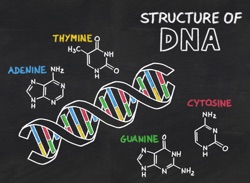Before we design courses, textbooks, assessments, labs, we need to determine what is important to teach in Introductory Biology. I think we’ve failed to do that, or at the very least confused concepts with content. Part of the problem is historical–textbooks are a product of inertia, each new one modeled on the ones that came before rather than initiated de novo to reflect principles in biology or pedagogy. Secondarily, I think a lot of effort in revamping biology curricula is being driven by older efforts in Chemistry and Physics, where a lot of the critical material is more operational and less conceptual. I’m writing this post to lay out one possible schema.
in Introductory Biology. I think we’ve failed to do that, or at the very least confused concepts with content. Part of the problem is historical–textbooks are a product of inertia, each new one modeled on the ones that came before rather than initiated de novo to reflect principles in biology or pedagogy. Secondarily, I think a lot of effort in revamping biology curricula is being driven by older efforts in Chemistry and Physics, where a lot of the critical material is more operational and less conceptual. I’m writing this post to lay out one possible schema.
What’s important about… - 3. page
What’s important about… ATP?
Every Intro Bio student can cite ATP as ‘the energy currency of the cell’… but what do we mean by that? And why does it play that role? These are important questions, and they deserve answers. And real ones, not invocation of the mystical ‘high energy bonds’.
Perusing Wiki for an image to link for ATP, I’m surprised to find how many directly imply that the ‘value’ is in the bond between two phosphates. I think suggesting that this is the case does a disservice to students’ ability to analyze and understand. We’ve taught them by now that bonds are simply shared pairs of electrons. Blaming the bond for the potential energy inevitably raises the question “Is it the electrons that are special? If not, what is it about the bond?”. No and nothing.
What’s important about… biology’s Central Dogma?
‘What to teach’ in Introductory Biology presents a whole host of conundrums. Is our role to cover the breadth of all of biology (or all of the biology student will hear again in upper divisions) at breakneck pace and without depth? A whirlwind tour of vocabulary to commit to memory with vague understanding for some later date? I will argue periodically that we should pick a limited, integrated fraction of possible content and teach it in a way that allows students to see and grasp underlying concepts and universal themes, thereby enabling them to figure out what comes later, and to embark on their own to investigate whatever catches their fancy.
The key ideas of biology’s Central Dogma–or better put, the flow of information— are a critical case in point. We all agree that ‘something’ about DNA, RNA and protein is among our core duties. But what? My view is that identifying the roles of each of these players, how their structures fit them to play those roles, how they came to occupy and the ‘flow’ between them them are straightforward, core ideas in biology.
What’s important about… the TCA Cycle
The Kreb’s cycle/TCA cycle/Citric acid cycle is a cornerstone of most introductory biology discussions of energetics. Boy is it scary to look at, but what a wonderful opportunity to make students memorize names and structures! But seriously… short of asking students to know everything about everything, what are the core concepts that they ‘ought’ to understand?
To my mind, two words: energetic electrons
What’s important about… molecules of the Central Dogma?
 I think we’re focusing on the wrong thing when we follow classical textbook approaches to ‘Biomolecules’ and their categories (DNA, RNA, protein, carbs, lipids). I don’t have much to say about the latter two, but there are some Big Ideas about the molecules of the central dogma that I believe get lost in the tedium of -OH groups and dehydration reactions… I’ll discuss order of presentation and such later; now I want to talk about monomer structure. To wit: How are (the group nucleic acid monomers) and (the group amino acids) all similar, and why must this be so?
I think we’re focusing on the wrong thing when we follow classical textbook approaches to ‘Biomolecules’ and their categories (DNA, RNA, protein, carbs, lipids). I don’t have much to say about the latter two, but there are some Big Ideas about the molecules of the central dogma that I believe get lost in the tedium of -OH groups and dehydration reactions… I’ll discuss order of presentation and such later; now I want to talk about monomer structure. To wit: How are (the group nucleic acid monomers) and (the group amino acids) all similar, and why must this be so?
What’s important about… teaching DNA?
 Everybody agrees that we should teach the ‘Central Dogma’ in IntroBio (DNA => RNA => Protein). But surely that’s not an answer to the question. What is important to understand about the actors and the ‘flow of information’ [what’s information?], why does each actor have the role it has, why are the actors chemically as they are and not otherwise (to paraphrase Einstein). As part of this blog, I’m going to go through views I’ve developed over two decades, starting with DNA. Foreshadowing: it’s not going to be about alphabets: the letters D-N-A and the letters A-G-C-T cannot encompass what is important about a molecule capable of holding in its structure the instructions-to-build for every known living thing.
Everybody agrees that we should teach the ‘Central Dogma’ in IntroBio (DNA => RNA => Protein). But surely that’s not an answer to the question. What is important to understand about the actors and the ‘flow of information’ [what’s information?], why does each actor have the role it has, why are the actors chemically as they are and not otherwise (to paraphrase Einstein). As part of this blog, I’m going to go through views I’ve developed over two decades, starting with DNA. Foreshadowing: it’s not going to be about alphabets: the letters D-N-A and the letters A-G-C-T cannot encompass what is important about a molecule capable of holding in its structure the instructions-to-build for every known living thing.
- « Previous
- 1
- 2
- 3
